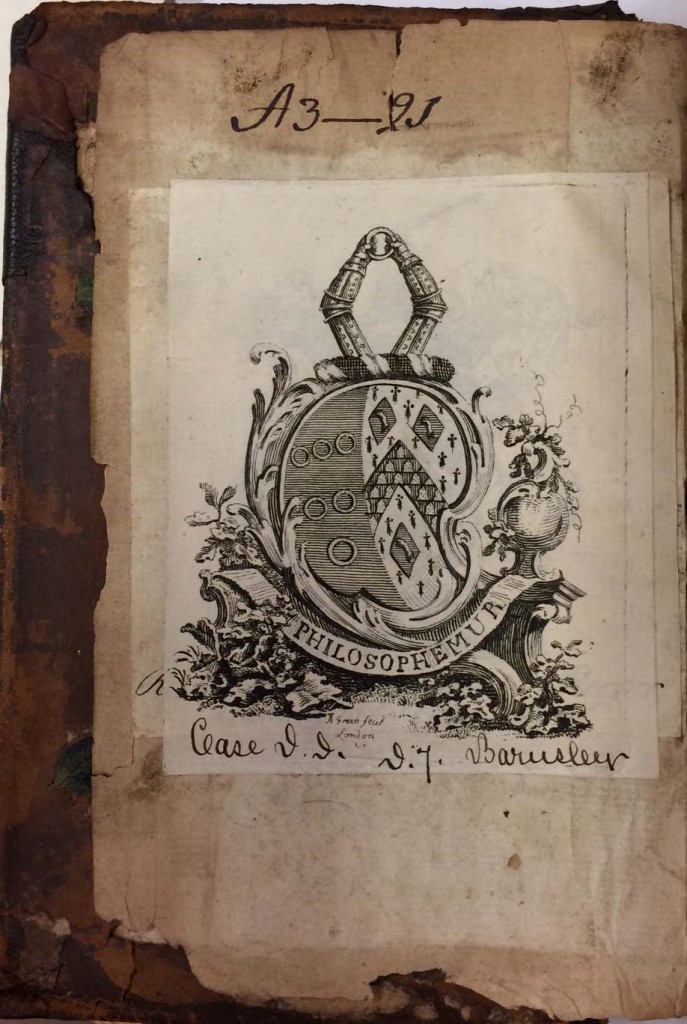Columbia’s printed Judaica collection is composed of many different books, each with their own story to tell. Unfortunately, however, only about 1/3 of our books were actually in our online catalog. To rectify this, we hired Hannah Vaitsblit, a Barnard student who has been carefully checking every Judaica book in our rare stacks to make sure that they are cataloged and thus accessible and known to any potential users. One of the things that Hannah has excelled at is marking instances of provenance, that is, notes indicating ownership of the book throughout its existence. One of the books that Hannah found was a Latin copy of Josephus’s De Bello Judaica (Wars of the Jews), printed in Cologne in 1559. Hannah indicated the presence of the bookplate shown here, noting the presence of the “Philosophemur”  shield as well as the Case information below it as she entered the record for the book into CLIO.
shield as well as the Case information below it as she entered the record for the book into CLIO.
The record was discovered by Newton scholar Professor Stephen Snobelen, who contacted us asking for more information about the book. He asked us if there was an indicator of “A3-21,” which was the classmark for this book in the Musgrave library (one of the libraries that owned Newton’s books).
A note on Professor Snobelen’s depth of research: Hannah had originally transcribed the last word in the text on the bottom of the plate as “Barusleer.” Since Prof. Snobelen is well versed in the travels of Newton’s library (described further below), he asked if it was possible that the text read “Barnsley.” A careful viewer can see that either reading is possible, but we know now that it was the latter.
After Isaac Newton’s death, John Huggins, his neighbor, purchased the library for £300. (His bookplate can be seen peeking out underneath the “Philosophemur” plate.) The collection went from Huggins to his son Charles, and from Charles Huggins to James Musgrave, whose bookplate is seen above, with the family motto, “Philosophemur.” The library remained in the Musgrave family for generations, moving with them in 1778 to Barnsley Park, Gloucestershire, where the new classmarks were added in ink (on the bottom of the plate). The library was partially sold at auction in 1920, when it is likely that this book entered the market, ultimately ending up at Columbia in 1922.
Columbia has several other bound works already known to have belonged to Newton (note that the first codex includes five volumes bound together):
SMITH 512.2 1690 R18: (a) Analysis aequationum universalis seu ad aequationes algebraicas resolvendas methodus generalis, et expedita, ex nova infinitarum serierum doctrina deducta ac demostrata, by Joseph Raphson (London, 1690). This book was presentated to Newton by the author, and includes the author’s inscription and initials (b) Methodes nouvelles et abbregees pour l’extraction et l’approximation des racines et pour resoudre par le cercle et la ligne droite, plusieurs problemes solides & sursolides by Thomas Fantet de Langny (Paris, 1692) (c) Christiani Hugenii…Astroscopia compendiaria, tubi optici molimine literata, by Christiaan Huygens (Hague, 1684) (d) (d) Reglement ordonné par le roy pour l’Académie royale des sciences du 26 de janvier 1699 (Paris 1699) (e) Abregé des observations & des reflexions svr la comete qui a paru au mois de decembre 1680, & aux mois de ianvier, fevrier, & mars de cette anneé 1681, by Giovanni Cassini (Paris, 1681)
SMITH 930 1587 Z75: Historia rervm in Oriente gestarvm ab exordio mvndi et orbe condito ad nostra haec vsqve tempora (Francof. ad Moenum, 1587)
PLIMPTON 520 1651 W72: Harmonicon coeleste : or, The cœlestiall harmony of the visible world (London, 1651)
You can read the stories of some other discoveries of Newton books at the Huntington Library (Mede’s Works), at the King’s C ollege Library (interestingly, a Hebrew lexicon), at the University of Michigan‘s library, and at Cardiff University.